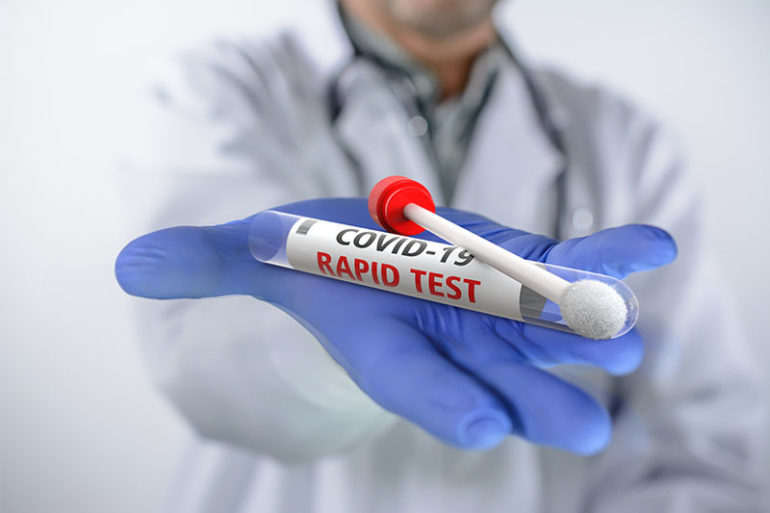When the novel coronavirus pandemic spread across the globe, governments and institutions worldwide faced hard decisions about who to test for the virus—and when—with limited testing supplies.
Now, a new algorithm developed by researchers at Penn State’s College of Information Sciences and Technology could help leaders make better informed decisions on how many symptomatic and asymptomatic individuals to test with rationed daily tests, and at what stage of the pandemic. The model’s simulated testing strategies resulted in approximately 40% fewer infections.
“Our goal was to find out how do you distribute an allocation of tests that you have every day,” said Amulya Yadav, PNC Technologies Career Development Assistant Professor at the College of IST. “How do you distribute them among symptomatic and asymptomatic people? And how should this allocation change over time?”
Using an artificial intelligence model known as Partially Observable Markov Decision Processes, Yadav’s team developed a sequential policy for distributing tests among a population. Their model, called Design of Optimal COVID-19 Testing Oracle, or DOCTOR, was measured against other existing testing strategies used by governments and institutions. Many of these other strategies are static and nonadaptive, potentially causing significant shortcomings in their effectiveness in containing COVID-19.
In a two-phased approach, DOCTOR first suggests spending more effort in testing symptomatic individuals, allocating approximately 65% of its available testing kits for individuals presenting symptoms. Over time, as the number of symptomatic individuals diminishes due to these patients moving to quarantine or hospital settings, DOCTOR shifts its attention to asymptomatic testing, gradually increasing the number of testing kits allocated to asymptomatic individuals as decision points proceed.
“This is a complicated AI program, and it’s unlikely that we can convince governments and institutions around the world to use a program and based on the output of that program decide your COVID-19 testing strategy,” said Yadav. “But we can look at the strategy and derive insights and pass those insights to those governments and institutions.”
When applied in a simulation to the city of Santiago in Panama—a country with the world’s highest rate of COVID-19 infections per capita—the model’s testing strategy outperformed state-of-the-art baselines by achieving approximately 40% fewer COVID-19 infections. This illustrates the benefit of having an adaptive strategy, and even more so with new variants of the virus emerging, according to Yadav.
“There is a possibility that testing is still going to be a part of our COVID-19 prevention efforts in the next year,” he said. “Even if vaccines work on the new variants as well, I think there is going to be a difference or a divide between developed and underdeveloped countries and how quickly they are able to vaccinate their populations.”
He added, “So testing is going to be much more important.”
Yadav also underscored at what stage of the pandemic an AI-driven testing strategy for COVID-19 would be most beneficial. His research shows that the use of AI is most beneficial when the pandemic spread is intermediate—meaning it’s not too severe and it’s not too slow.
“If the pandemic is at its highest severity, then intuitively, there’s very little you can do in terms of optimizing mitigation responses, and therefore, AI is not able to help much,” said Yadav. “On the other side, if the pandemic is just about starting to spread, then intuitively, you don’t really need to be that clever in optimizing your mitigation responses, so just about any strategy would work well. It’s only when the pandemic is in its intermediate phase when the benefits of an AI driven long-term COVID-19 testing strategy are most pronounced.”
As COVID-19 is currently in an intermediate stage in many places worldwide, it is an optimal time for governments and institutions to consider an AI-driven testing strategy. Additionally, the model could be useful in guiding decision makers in the event of a future pandemic.
“I’d be very glad if we don’t require this model to ever be used, and that COVID-19 passes us without the insights ever having to be used,” said Yadav. “But it could allow us to prepare for the next pandemic, and if and when that happens, we’ll know what we need to do and what testing strategies can make the biggest impact.”
Follow the latest news on the coronavirus (COVID-19) outbreak
Provided by
Pennsylvania State University
Citation:
AI-defined COVID-19 testing strategy could lead to fewer infections (2021, January 22)
retrieved 24 January 2021
from https://medicalxpress.com/news/2021-01-ai-defined-covid-strategy-infections.html
This document is subject to copyright. Apart from any fair dealing for the purpose of private study or research, no
part may be reproduced without the written permission. The content is provided for information purposes only.



